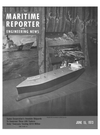
Page 13: of Maritime Reporter Magazine (June 15, 1973)
Read this page in Pdf, Flash or Html5 edition of June 15, 1973 Maritime Reporter Magazine
Maritime Day- (Continuod from page 13) dress said the drift and decline of the U.S.-flag shipping fleet has been dramatically reversed due to the courage and determination of
U.S. operators and investors with the help of the 1970 Merchant Ma- rine Act's shipbuilding program.
As a result, he added, U.S. com- mercial shipbuilding is now at its highest level in peacetime history.
Referring to the Department of
Defense's shipping policies, Mr.
Reynolds stated: "There must be a firm policy applicable to all gov- ernment departments and agencies that our U.S.-flag liner operators will be given first priority in trans- porting government shipments.
The time is long overdue for the
DOD and others to stop amassing their own empire of ships, to char- ter vessels only when berth serv- ice i's not available, and to stop relying on operators who do not have modern fleets, who have no building or modernizing plans and who in brief are merely trying to squeeze the last dime out of their totally obsolete ships."
Referring to 'the inequities of for- eign competition where foreign- flag operators and/or their govern- ments restrict trade or undercut rates, he said, "I believe that the time has come to insure that our operators are able to compete on an equal basis with foreign liners.
This is required in the national in- terest, not ,only to support our merchant marine but also to pro- tect our trade and alleviate our payments deficits." He suggested that the solution might take the form of new legislation giving some senior government official the re- sponsibility for annually reviewing all our liner trades and determining in each specific trade corrective steps to be taken to protect U.S. interests.
Seattle, Wash.—Howard. F. Ca- sey, deputy Assistant Secretary for
Maritime Affairs, spoke at the Pro- peller Club luncheon in Seattle. He basically reviewed the results of the 1970 Merchant Marine Act. These results he listed as: "Shipyard orders aggregating over $1.7 billion in new construc- tion and conversions have been placed. These orders—covering 37 new ships and 16 conversions of conventional freighters into con- tainerships — have resulted in
American shipyards aggregating the largest backlog of merchant- ship orders in their peacetime his- tory. "These ships will considerably upgrade the ability of the U.S.-flag fleet to carry American foreign trade, since t'hey represent a 'quan- tum jump' in productivity over the older vessels in the fleet. "The tank vessels ordered to date present an even more dramatic situ- ation with respect to productivity.
Sixteen ships, ranging in size from 35,000 to 265,000 tons, have been ordered. These vessels represent the equivalent of more than 25 per- cent of the current deadweight capacity in the U.S. tanker fleet. "And the liquefied natural-gas tankers and combination ore/bulk/ oil carriers in the shipbuilding pro- gram are the first vessels of these classes to be built in this country. "All of these ships will be less dependent on government operat- ing subsidy than their predeces- sors. As you know, the differential between foreign and U.S. wage scales comprise the bulk of each operating subsidy dollar. But these new ships will have considerably smaller crews than older ships. In fact, while crew complements on older ships range from 40 to 50 men, manning scales on the new ships being built range from 26 to 32."
San Diego, Calif.—-Following his talk in Seattle, Mr. Casey spoke the following day at the Propeller Club luncheon in San Diego. In this talk he stressed what shipyard's were doing to improve their posture. He said: "The American shipyards have responded affirmatively to the productivity challenges inherent in the President's program. During the past few years they have ex- pended more than $100 million on plant improvements which increase efficiency and reduce construction costs. The construction of three entirely new shipyards costing over $100 million each is expected to get underway within the next year or two. "In summary, on this Maritime
Day, 1973, our maritime industry can be proud of the enormous pro- gress it has made in restructuring its operations to establish a strong foundation for .future growth."
CUTS FIELD ASSEMBLY COSTS
OVER 75 YEARS OF SERVICE. . . transporting massive products and fully-assembled steel fabrications. Hughes modern fleet of barges, scows and floating equipment available on the Atlantic Coast, the Great Lakes and St. Lawrence Seaway. For economy call
JAMES HUGHES, INC. 75 YEARS
CLEARING
I.C.C. W-463 17 Battery Place, New York, N.Y. 10004 Tel. 212 WHitehall 4-1048
HOUSE FOR MARINE DIFFICULTIES SINCE 1894 k&sjMts inc.
June 15, 1973 15

 12
12

 14
14
